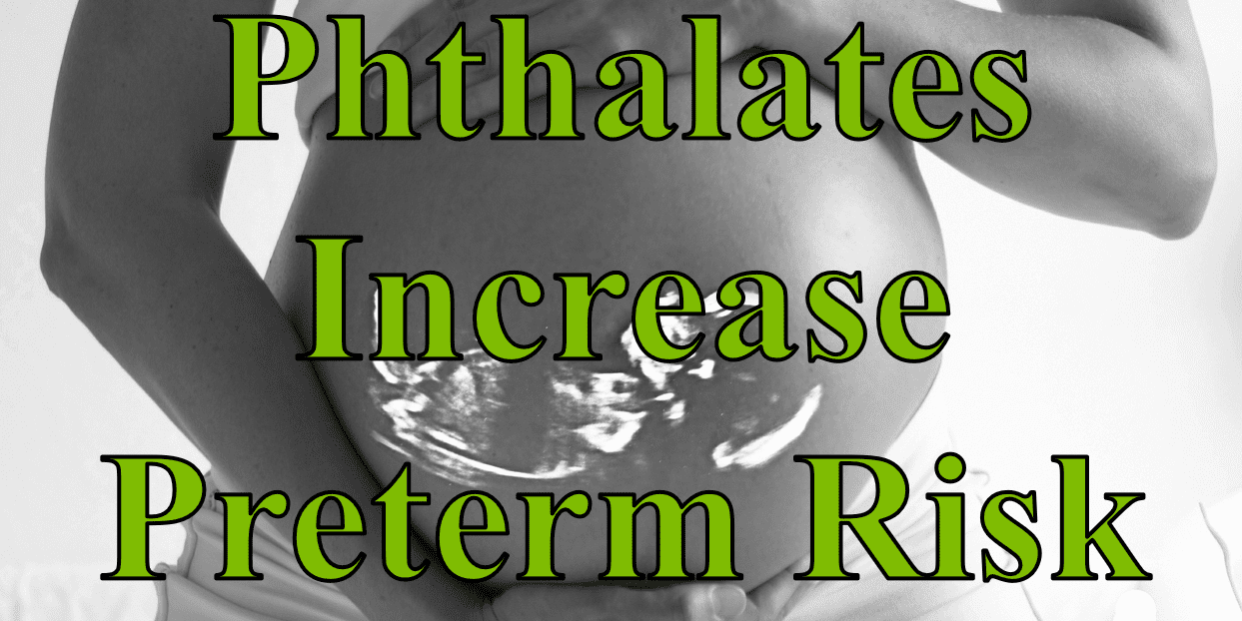I am always amazed at how we can consider our society as so advanced when we so blatantly poison ourselves with so many chemicals. We can look back and arrogantly belittle ancient uncivilized societies who poisoned themselves with lead in their water or drank from the waters in which they sacrificed. However, no matter how many studies come out about the risk associated with mass produced chemicals like phthalates, the majority of the world can carry on like nothing is happening, like no tragedies are occurring.
This study adds further proof of the absurdity. The prestigious Journal of the American Medical Association tells us that not only were “most” of the 11 tested phthalate metabolites found in 96% of study subjects, but 4 of those elevated metabolites were associated with an apparent risk of preterm birth. Basically, increasing levels of these breakdown products of phthalates were linked to babies being born early, an occurrence that puts these children at risk for complications short and long-term.
So often, medical studies present statistics and make claims about their findings without putting the statistics into real world impacts. Saying that two things are connected without working out the details of what we can really do about the finding does not really help us as medical providers or as individuals looking for answers. In this case, the authors went beyond claiming a connection and actually gave us a sense of what we could do about this problem. They noted that 90 in 1000 live births come as preterm births. They then estimate that interventions to lower the phthalate exposure during pregnancy by 10%, 30%, or 50% could lower the 90 per 1000 by either 1.8, 5.9, or 11.1 respectively. Of course we have to consider what effort this degree of lowering would require, but at least it provides a sense of impact we might get out of our efforts.
If this is news to you, your first question should be “where are phthalates coming from?” While not my usual top source of scientifically trustworthy data, the CDC (Centers for Disease Control and Prevention) runs a National Biomonitoring Program and offers the following information on their website (https://www.cdc.gov/biomonitoring/Phthalates_FactSheet.html).
“Phthalates are in hundreds of products, such as vinyl flooring, lubricating oils, and personal-care products (soaps, shampoos, hair sprays).
“Some phthalates are in polyvinyl chloride plastics, which are used to make products such as plastic packaging, garden hoses, and medical tubing.
How People Are Exposed to Phthalates
People are exposed to phthalates by eating and drinking foods that have contacted products containing phthalates. Some exposure can occur from breathing phthalate particles in the air. Children crawl around and touch many things, then put their hands in their mouths. Because of that hand-to-mouth behavior, phthalate particles in dust might be a greater risk for children than for adults. Inside a person’s body, phthalates are converted into breakdown products (metabolites) that quickly leave the body in urine.”
To lower these exposures, we need both policies and personal choices pressed repeated upon the world in which we live. To the knowledge of the harmful effects to mothers and their babies and other studies showing other health effects, we must add knowledge of which products pose the greatest risk to us. Then we must choose to avoid those products whenever possible. The market pressure of a population who refuses to buy phthalate containing products will go a long way. From there, we can provide information for our governmental officials tasked with legislative decisions so that they can make informed decisions on whether some of these chemicals should be regulated, restricted, or forbidden.
Helping ourselves and helping the next generation live healthier more abundant lives includes a million little decisions occurring daily in our lives. What we eat, how much we exercise, and which toxic products we consume or avoid each play a role in our health. Learn for yourself and choose the best for yourself.
Focus Article:
Welch BM, Keil AP, Buckley JP, et al. Associations Between Prenatal Urinary Biomarkers of Phthalate Exposure and Preterm Birth: A Pooled Study of 16 US Cohorts. JAMA Pediatr. Published online July 11, 2022. doi:10.1001/jamapediatrics.2022.2252
Sanctuary Functional Medicine, under the direction of Dr Eric Potter, IFMCP MD, provides functional medicine services to Nashville, Middle Tennessee and beyond. We frequently treat patients from Kentucky, Alabama, Mississippi, Georgia, Ohio, Indiana, and more... offering the hope of healthier more abundant lives to those with chronic illness.







